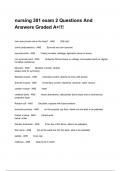nursing 301 exam 2 Questions And
Answers Graded A+!!!
how many bones are in the body? - ANS 206 (ish)
Joints (articulations) - ANS Synovial and non synovial
synovial joints - ANS Freely movable, cartilage, ligaments (bone to bone)
non synovial joints - ANS United by fibrous tissue or cartage, immovable (skull) or slightly
movable (vertebrae)
Muscles - ANS Skeletal, smooth, cardiac
always look for symmetry
Skeletal muscle - ANS Voluntary control, attache to bone with tendon
Smooth muscle - ANS Involuntary control, intestines, stomach, other viscera,
cardiac muscle - ANS heart
vertebral body - ANS shock absorbents, callousness bone tissue and is encircled by
protective layer
Rotator cuff - ANS Shoulder, capsule with fused tendons
acromion process - ANS on the scapula, top front, sticks out and able to be palpated
Carpal v tarsal - ANS Carpal-wrist
tarsal- ankle
Greater trochanter - ANS Front top of the femur, able to be palpated.
Iliac spine - ANS Top of the waist line into the back, able to be palpated
patella - ANS knee cap
malleous - ANS large bone in ankle
,infant and children life span considerations - ANS Legs: Bowlegged until 18 months,
transition to knock-knee, legs straighten by 6-7 years,
skull fontanels close by 18-24 months(ant) 3(Post)
Screen for scoliosis from (10-16 years)
older adult lifespan considerations - ANS Osteoarthritis, osteoporosis, decreased agility,
strength, and endurance
Subjective health history musculo-skeletal - ANS Pain, stiffness, swelling, heat and
redness, deformity, limited movement, accidents, trauma, injury, ability ADL's, occupational
hazards, exercise
objective data musculo-skeletal - ANS Order of the examination, proximal to distal and
head to toe.
Inspection for musculo-skeletal - ANS Size and contour and joint, skin and tissues over
joint
Inspect integument for scars, rashes, busing, erythema or lesions, deformity and atrophy
Compare side to side for symmetry
Palpation for musculo skeletal - ANS skin temperature, muscles, bony articulations, area of
joint capsule.
Examine each major joint and muscle group.
Identify tenderness, deformities,
ROM musculo skeletal - ANS Look for something specific in each joint, each has a specific
movement.
Maximum amount of movement available at a joint in one of three plains.
Limited by ligaments, muscles and nature of joint
Prevents contractures and maintains tone
Muscle testing musculo skeletal - ANS see neurological assessment, apply opposing force,
Grading muscle strength
when combining musculo skeletal with neuro... - ANS we move distal to proximal
What would you do next after performing palpation and find swelling or a possible fracture? -
ANS a neuro and vascular exam.
ROM continued - ANS Perform full active ROM, always compare side to side keeping in
mind normal developmental changes.
How much and often should passive ROM be preformed - ANS 3x day, 3x per joint.
,Crepitus - ANS Cracking of joint, decreased muscle tone limit range or hyper range.
assessing passive ROM - ANS Crepitus, muscle tone, Decreased ROM (arthritis),
Increased ROM (joint laxity)
Extention ROM - ANS increase angle of joint
flexion ROM - ANS decrease angle of joint
deviation - ANS moving wrists in and out on a horizontal line
inversion and eversion - ANS
external rotation - ANS being arrested
internal rotation - ANS back of hands on lower back
phalen test - ANS for carpal tunnel
tinel sign - ANS numbness or tingling in the fingers.
How to check a baby's internal and external rotation - ANS scrunch up their knees and flex
back, circumflex the hips
what angle should the knee bend to? - ANS 130 degrees
what should you check for while the client is flexing their spine? - ANS scoliosis
Central nervous system - ANS Components; brain & spinal cord.
Efferent messages are sent out via peripheral system to muscles & glands
Autonomic messages are sent out to control internal organs & blood vessels
Peripheral nervous system - ANS 12 pairs of cranial nerves, 31 pairs of spinal nerves,
afferent messages travel to the CNS from sensory receptors
Central nervous system- cerebral cortex - ANS 80% of brains total weight
responsible for thought, voluntary muscle control, memory reasoning and problem solving
Four lobes of the cerebral cortex - ANS 1. Frontal- personality, intellect, behavior
2. Temporal- Hearing, taste, smell
3. Parietal- sensation
4. occipital- visual
2 halves of the brain - ANS Right side- controls the left of the body
, left side- control the right side of the body
Important to know regarding strokes.
Wernicke's area - ANS language composition
Damage=receptive aphasia
Broca's area - ANS motor speech
Damage= expressive aphasia, they know what they want to say but they can't.
Basal ganglia (autonomic) - ANS Movements and walking
Deep between the two hemispheres.
Thalamus - ANS Relays incoming sensory data
Control of emotions, a stroke here would cause someone to cry all the time.
Hypothalamus - ANS Temp, HR, BP, sleep, emotion, autonomic & pituitary
Major respiratory center
Damage= odd breathing patterns
Cerebellum - ANS 1/8 the size of the cerebrum
Controls balance, movement, tone and coordination
Damage= inability to walk or coordinate
Brainstem - ANS Connects the rest of the brain to spinal cord
Controls involuntary muscles (works automatically w/o thinking) Ex. heart, muscles in stomach.
Parts of the brain stem - ANS midbrain, pons, medulla
Midbrain - ANS motor & sensory tract
Pons - ANS Motor and sensory tracts
Coordination with the main respiratory center in the medulla
Medulla - ANS Autonomic center
RR, HR, GI
What will damage cause?
Spinal cord - ANS Reflexes, ascending/descending brain to spinal nerve connection.
Size of fingers... for catching things
Peripheral nervous system (PNS) - ANS Cranial nerves (12 pairs)
Spinal nerves (31 pairs)
Reflex arc (autonomic nervous system-nerves r/t unconscious activity)




